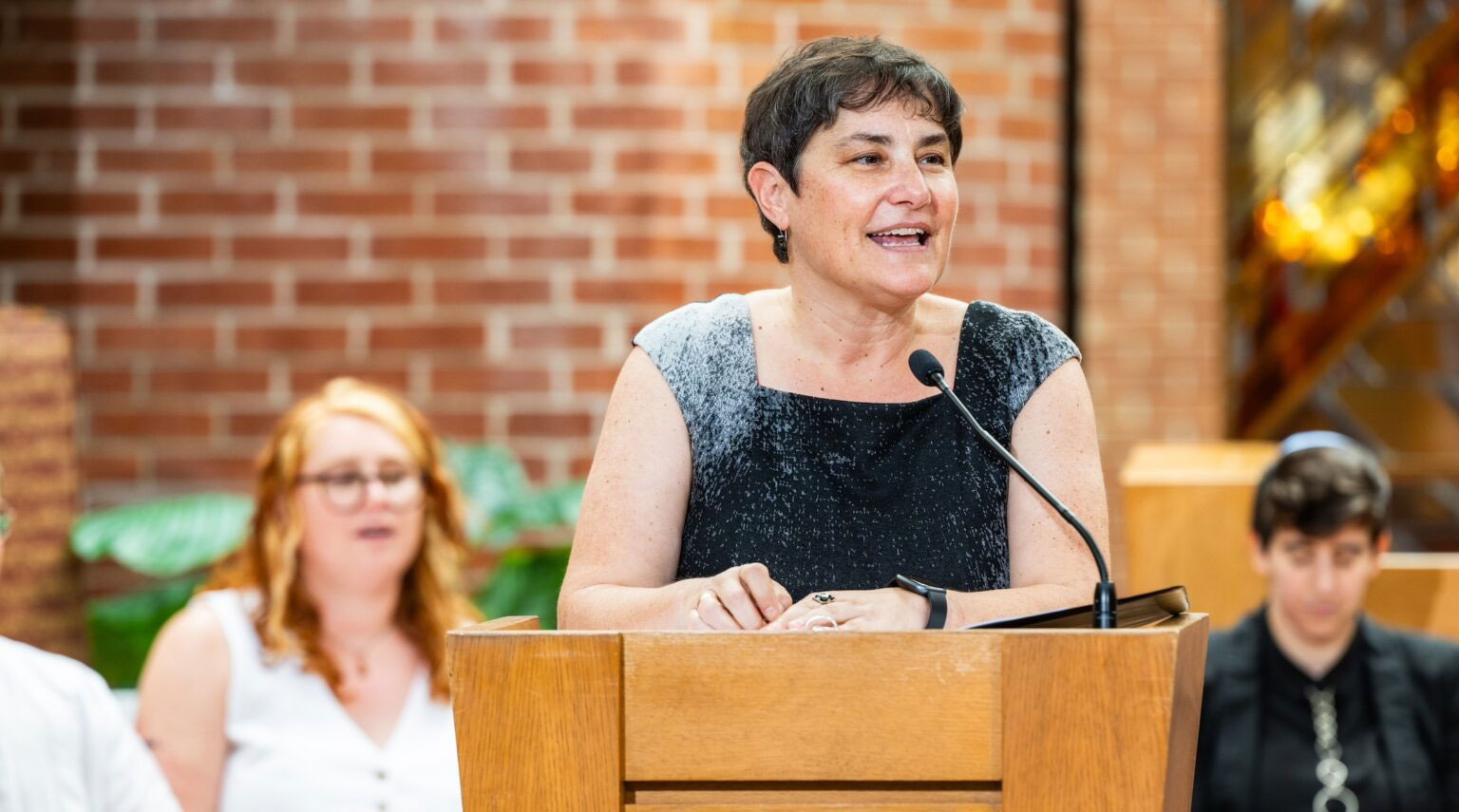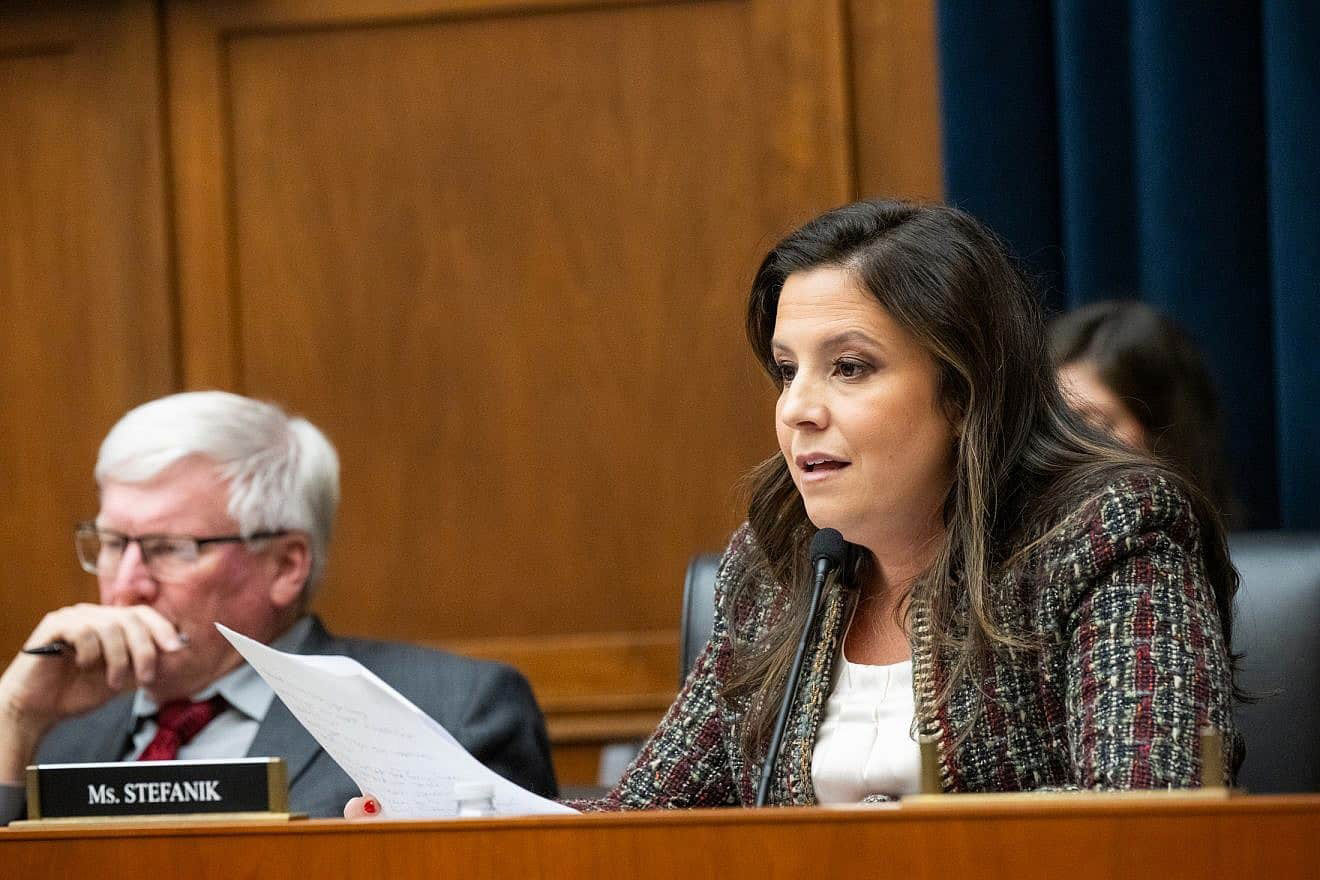Courtesy of JTA. Photo credit: Jackie Hajdenberg
Amari Benton (right) uses a virtual reality headset to walk through the streets of Munich as it was during Kristallnacht in 1938
(JTA) — Last week, the 10th grade students in Lisa Berke’s human rights literature class at Brooklyn’s Edward R. Murrow High School paid a visit to Holocaust survivor Charlotte Knobloch’s childhood haunts in Munich.
The students visited the home of Knobloch’s grandparents, decorated with family photographs and a prominent grandfather clock. They also glimpsed the streets of Munich, where there was a sign on the street that read, “Aryans only.” When they arrived at her school, it was then that Knobloch announced: “I realized that something was different the moment I went to play with the other children.”
But the 70 or so students who made this journey did so without time-traveling, and without ever leaving their school’s library, with its colorful murals of writers like Angela Davis, Nora Ephron and Pablo Neruda. Instead, their visit with Knobloch, who is 92 and lives in Munich, was entirely virtual.
Such virtual reality encounters are a new front in the effort to teach the Holocaust to younger generations, an endeavor deemed especially crucial as the number of Holocaust survivors continues to decline. (In January, the Conference on Jewish Material Claims Against Germany found that some 245,000 Holocaust survivors are still living across more than 90 countries, with a median age of 86.) As such, the Claims Conference commissioned the USC Shoah Foundation and makemepulse, an immersive technology company, and partnered with Meta and UNESCO to create a digital “mixed-reality” tour of Knobloch’s early life.
Ahead of the 86th anniversary of Kristallnacht, the Nazi-led pogrom of Nov. 9-10, 1938, the Claims Conference piloted the project, called “Inside Kristallnacht,” at Murrow High School in Midwood and at another high school in Asbury Park, New Jersey.
“Up to a few years ago, all you had was that personal testimony,” Gideon Taylor, the president of the Claims Conference, said, adding that in a few years there will be few first-hand witnesses. “And you’re just at this moment here where there’s an overlap. But in the big scheme, there’s a tiny period where you’ll have in the same room, a person speaking and someone on a headset.”
During their virtual visit to Munich, the Murrow students heard Knobloch’s description of her life in the two years leading up to Kristallnacht. They also observed the destruction of the city’s Jewish-owned department store, Uhlfelder, as well as its synagogue, Ohel Jakob.
The aims of the virtual reality project are to “create a sensitive and evocative mixed-reality experience animating Knobloch’s memories in a powerful, minimalist way, delivering to users a deeper, more emotional understanding of Knobloch’s survival, of Kristallnacht and of the years that followed,” the Claims Conference said in a statement.
Knobloch, who was 6 when Kristallnacht took place, survived the Holocaust by hiding with Catholic farmers in the Franconia region of Germany. Today, she is one of the best-known Jews living in Germany, having served as the president of the Central Council of Jews in Germany from 2006 to 2010, and is known as an activist against the country’s far right.
“Being part of this high-tech experience gives me great pride,” Knobloch said in a statement. “There are fewer survivors every year who can share their memories of the Holocaust and knowing that the lessons they have to share will last beyond any of us gives me hope for the future and makes me feel that those lessons will not be lost.”
When Inside Kristallnacht participants place the VR headsets over their heads, they hear Knobloch tell her story, which begins in her grandparents’ living room as it was in 1936. During the experience — which includes archival photos and videos, along with pre-recorded video and audio testimonials from Knobloch — users can ask Knobloch’s VR self questions using text or speech.
“I think it’s amazing, the advancement of technology and being able to use that to help keep my students educated, informed, and engaged is just so special,” Berke, the literature teacher, said. “I think it always helps to add things that I can’t. A survivor telling their story using virtual reality is phenomenal.”
On that Monday in October, Berke’s students were also fortunate to hear from two Holocaust survivors in real life — in addition to the virtual experience, local survivors Ellen Bottner and Kurt Goldschmidt also came to speak with the class.
That afternoon, Bottner recounted her experience on the Kindertransport, the operation to evacuate Jewish children from Nazi-occupied Europe. She described how when she was finally reunited with her parents at New York’s Penn Station she no longer recognized them.
Most students were most rapt by her story, though of course a few teens were on their phones or anxiously clutching their backpacks, waiting for the bell to ring to head to their next class. But the vast majority of Berke’s students stuck around after the period ended, asking Bottner and Goldschmidt questions about their early lives and their adjustment to life in the United States as survivors and immigrants.
Berke’s students had already studied the Holocaust in their class, having recently read Elie Wiesel’s memoir “Night.” But Berke, who has taught the literature class at Murrow for more than 12 years, said she noticed a considerable difference in the way students pay attention when there are survivors that they can interact with.
“This is when you see that empathy that exists in all of them,” she said.
The significance of having a virtual reality experience with a survivor alongside the opportunity to hear from two survivors IRL was not lost on the students, either.
Sophomore Roan Porter said he had vague recollections hearing a Holocaust survivor speak at his elementary school. But the Claims Conference event was particularly special, he said.
“I think it was just really interesting and important to see this information in the form of VR take a new and modern form, so that it’s more accessible for a new generation,” Porter said. “And hearing from the Holocaust survivors, I feel like it allows us to dig deeper into history.”
Porter’s friend and classmate Amari Benton also appreciated being able to hear directly from Holocaust survivors. “It could show other generations why this happened,” Benton said.
For Mia Crosa, putting the headset on and walking through Knobloch’s grandparents’ living room helped make the Holocaust more tangible.
“When we were reading ‘Night,’ I honestly — sometimes I forget that it’s really real and that these events have actually happened,” Crosa said. “So hearing other people’s perspectives and the whole stories from other people, just honestly, gave me a different mindset about it and a different perspective.”
“It’s something I definitely think about more now and I’ll keep thinking about it or something will remind me of what I’ve been learning,” she added. “Just hearing from the survivors today makes me think that I should be a lot more grateful about my own life.”





